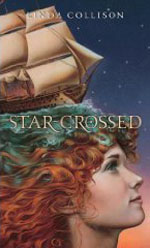 I started reading nautical fiction, specifically C.S. Forester’s Hornblower series, as a teenager. The Hornblower novels, while meant for adults, were great “boy books,” full of adventure and action, with a hero with just enough self doubt and angst for a teenager to relate to. The readers of most nautical fiction seem to be primarily boys and men, which is not surprising for a genre whose heroes and villains are overwhelming male. Is there room for female readers and indeed a female heroine in these crowded waters? And if so, what role could she and would she play? After reading Linda Collison’s novel, Star-Crossed, the answer to the first question is clearly yes.
I started reading nautical fiction, specifically C.S. Forester’s Hornblower series, as a teenager. The Hornblower novels, while meant for adults, were great “boy books,” full of adventure and action, with a hero with just enough self doubt and angst for a teenager to relate to. The readers of most nautical fiction seem to be primarily boys and men, which is not surprising for a genre whose heroes and villains are overwhelming male. Is there room for female readers and indeed a female heroine in these crowded waters? And if so, what role could she and would she play? After reading Linda Collison’s novel, Star-Crossed, the answer to the first question is clearly yes.
The second question is less easy to answer and indeed is the heart of the novel. Linda Collison brings an established archetype to life in a fresh and wonderfully authentic tale of a young lady seeking her place in the world while caught in the fever-ridden islands of the Indies in the midst of the Seven Year’s War.
In Star-Crossed, Patricia Kelly, the illegitimate daughter of a recently deceased plantation owner, stows away aboard a merchantman bound for the West Indies in hopes of reaching Barbados and claiming her father’s plantation as her inheritance. All does not go as she had planned. She is discovered aboard ship but allowed to work as a loblolly boy, an assistant to the ship’s surgeon. On arriving in Barbados, she learns that her father’s plantation has been sold and that she must abandon her school girl dreams and face the grim reality before her. This includes a marriage of necessity to the ship’s surgeon, outbreaks of yellow fever, shipwreck, and the death of her surgeon husband. Along the way, she discovers that when dressed in sailor’s togs, she passes well enough for a young man, which will become critically important when her only suitable, if rather desperate, choice for employment is as a surgeon’s mate on a Royal Navy man-of-war about to sail off to war.
The book is categorized as “Young Adult” and because the main character is a young lady, the target reader is probably a high school girl. Being a considerable distance from that target audience, both in age and gender, I wondered whether I would enjoy the book. I did indeed. Collison’s skill as a writer and her extensive research lends a real authenticity to the novel, and kept me turning the pages.
I can think of, though probably need not name, several very popular authors who have written about sailing ships without any real understanding of their subject matter. For many readers this is probably OK. For fans of nautical fiction, all the “sailors pulling on the ropes” nonsense can be most unpleasant. Collison, however, knows her subject. In addition to her research, Collison has sailed as volunteer crew on the replica of the HMS ENDEAVOUR . She doesn’t overload the reader with jargon or detail, but that which she uses, feels exactly right.
Likewise, key sections of the book deal with the practice of medicine in the mid-18th century. Her portrayal of the airless deck on a hospital ship or the sweltering heat of a field hospital are harrowing, capturing the sights, sounds and stench of the sick and the dying. One critical detail, often left out by writers of historical fiction, is that soldiers and sailors in the 18th century were far more likely to die of disease than in battle. Readers of Star-Crossed are not likely to forget this bit of history.
Patricia becoming Patrick and signing aboard aboard a Navy ship, also feel authentic. The story of young women and girls who dress as men and run off to sea has a long tradition in song and story. It has often been dismissed a simple male fantasy, yet the number of documented cases suggests that it may indeed have not been that uncommon.
While the Hornblower books have long been the domain of men and boys, there has been a spike in female readership following the Emmy award-winning A&E mini-series of 1999. Perhaps Star-Crossed will provide another avenue for introducing girls and young women to nautical fiction. In any case, it is a great read, regardless of one’s age or gender.

Pingback: Interview with Linda Collison, author of Surgeon’s Mate : Old Salt Blog – a virtual port of call for all those who love the sea
Pingback: SURGEON’S MATE by Linda Collision – A Review : Old Salt Blog – a virtual port of call for all those who love the sea
Pingback: Linda Collison Interviews Alaric Bond | Old Salt Blog – a virtual port of call for all those who love the sea
Pingback: The Perfect Wreck by Steven E. Maffeo – a review by Linda Collison | Old Salt Blog – a virtual port of call for all those who love the sea
Pingback: America’s Privateer, Lynx and the War of 1812 — More than a Coffee Table Book, a Review by Linda Collison | Old Salt Blog – a virtual port of call for all those who love the sea